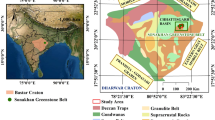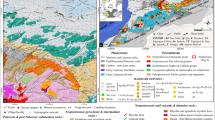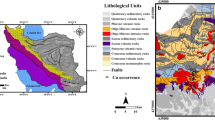Abstract
The Salafchegan area in central Iran is a greenfield region of high porphyry Cu–Au potential, for which a sound prospectivity model is required to guide mineral exploration. Satellite imagery, geological geochemical, geophysical, and mineral occurrence datasets of the area were used to run an innovative integration model for porphyry Cu–Au exploration. Five favorable multi-class evidence maps, representing diagnostic porphyry Cu–Au recognition criteria (intermediate igneous intrusive and sub-volcanic host rocks, structural controls, hydrothermal alterations, stream sediment Cu anomalies, magnetic signatures), were combined using analytic hierarchy process and technique for order preference by similarity to ideal solution to calculate a final map of porphyry Cu–Au potential in the Salafchegan area.










Similar content being viewed by others
References
Abedi, M., & Norouzi, G. H. (2012). Integration of various geophysical data with geological and geochemical data to determine additional drilling for copper exploration. Journal of Applied Geophysics, 83, 35–45.
Abedi, M., Norouzi, G. H., & Bahroudi, A. (2012a). Support vector machine for multi-classification of mineral prospectivity areas. Computers & Geosciences, 46, 272–283.
Abedi, M., Norouzi, G. H., & Fathianpour, N. (2013). Fuzzy outranking approach: A knowledge-driven method for mineral prospectivity mapping. International Journal of Applied Earth Observation and Geoinformation, 21, 556–567.
Abedi, M., Norouzi, G. H., & Torabi, S. A. (2012b). Clustering of mineral prospectivity area as an unsupervised classification approach to explore Copper Deposit. Arabian Journal of Geosciences, 6, 3601–3613.
Abedi, M., Torabi, S. A., Norouzi, G. H., & Hamzeh, M. (2012c). ELECTRE III: A knowledge-driven method for integration of geophysical data with geological and geochemical data in mineral prospectivity mapping. Journal of Applied Geophysics, 87, 9–18.
Abedi, M., Torabi, S. A., Norouzi, G. H., Hamzeh, M., & Elyasi, G. R. (2012d). PROMETHEE II: A knowledge-driven method for copper exploration. Computers & Geosciences, 46, 255–263.
Abrams, M. J., Brown, D., Lepley, L., & Sadowski, R. (1983). Remote sensing for porphyry copper deposits in southern Arizona. Economic Geology, 78, 591–604.
Aghanabati, A. (2004). Geology of Iran. Geological Survey of Iran: Ministry of industry and mines. 582 p.
Agterberg, F. P. (1995). Multifractal modeling of the sizes and grades of giant and supergiant deposits. International Geology Reviews, 37, 1–8.
Amos, B. J., & Greenbaum, D. (1989). Alteration detection using TM imagery: The effects of supergene weathering in arid climate. International Journal of Remote Sensing, 10, 515–527.
An, P., Moon, W. M., & Rencz, A. (1991). Application of fuzzy set theory for integration of geological, geophysical and remote sensing data. Canadian Journal of Exploration Geophysics, 27, 1–11.
Asadi, H.H. (2008). Final exploration report of Dalli porphyry Cu–Au deposit, Markazi province. Technical report. Dorsa Pardazeh Company.
Asadi, H. H., & Hale, M. (2001). A predictive GIS model for mapping potential gold and base metal mineralization in Takab area, Iran. Computers & Geosciences, 27, 901–912.
Asadi, H. H., Porwal, A., Fatehi, M., Kianpouryan, S., & Lu, Y. J. (2015). Exploration feature selection applied to hybrid data integration modeling: Targeting copper-gold potential in central Iran. Ore Geology Reviews, 71, 819–838.
Ayati, F., Yavuz, F., Asadi, H. H., Richards, J. P., & Jourdan, F. (2013). Petrology and geochemistry of calc-alkaline volcanic and subvolcanic rocks, Dalli porphyry copper–gold deposit, Markazi Province, Iran. International Geology Reviews, 55, 158–184.
Ayati, F., Yavuz, F., Noghreyan, M., Asadi, H. H., & Yavuz, R. (2008). Chemical characteristics and composition of hydrothermal biotite from the Dalli porphyry copper prospect, Arak, central province of Iran. Mineralogy and Petrology, 94, 107–122.
Bonham-Carter, G. F. (1994). Geographic information systems for geoscientists: Modelling with GIS (p. 398). Oxford: Pergamon Press.
Bonham-Carter, G. F., Agterberg, F. P., & Wright, D. F. (1989). Weights-of-evidence modelling: A new approach to mapping mineral potential. In F. P. Agterberg & G. F. Bonham-Carter (Eds.), Statistical applications in the earth sciences (pp. 171–183). Ottawa: Geological Survey of Canada.
Carranza, E. J. M. (2009). Geochemical anomaly and mineral prospectivity mapping in GIS. Handbook of Exploration and Environmental Geochemistry 11. New York: Elsevier.
Carranza, E. J. M. (2011). Geocomputation of mineral exploration targets. Computers & Geosciences, 37, 1907–1916.
Carranza, E. J. M., Hale, M., & Faassen, C. (2008). Selection of coherent deposit-type locations and their application in data-driven mineral prospectivity mapping. Ore Geology Reviews, 33, 536–558.
Carranza, E. J. M., & Laborte, A. G. (2015a). Data-driven predictive mapping of gold prospectivity, Baguio district, Philippines: Application of Random Forests algorithm. Ore Geology Reviews, 71, 777–787.
Carranza, E. J. M., & Laborte, A. G. (2015b). Data-driven predictive modeling of mineral prospectivity using Random Forests: A case study in Catanduanes Island (Philippines). Natural Resources Research. doi:10.1007/s11053-015-9268-x.
Carranza, E. J. M., & Laborte, A. G. (2015c). Random forest predictive modeling of mineral prospectivity with small number of prospects and data with missing values in Abra (Philippines). Computers & Geosciences, 74, 60–70.
Carranza, E. J. M., Mangaoang, J. C., & Hale, M. (1999). Application of mineral deposit models and GIS to generate mineral potential maps as input for optimum land-use planning in the Philippines. Natural Resources Research, 8, 165–173.
Cheng, Q. (1999). Spatial and scaling modeling for geochemical anomaly separation. Journal of Geochemical Exploration, 65, 175–194.
Clark, D. A. (2014). Magnetic effects of hydrothermal alteration in porphyry copper and iron-oxide copper–gold systems: A review. Tectonophysics, 624–625, 46–65.
Feizi, F., & Mansuri, E. (2013). Separation of alteration zones on ASTER data and integration with drainage geochemical maps in Soltanieh, Northern Iran. Open Journal of Geology, 3, 134–142.
Ford, A., Miller, J. M., & Mol, A. G. (2015). A comparative analysis of weights of evidence, evidential belief functions, and fuzzy logic for mineral potential mapping using incomplete data at the scale of investigation. Natural Resources Research. doi:10.1007/s11053-015-9263-2.
Gabr, S., Ghulam, A., & Kusky, T. (2010). Detecting areas of high-potential gold mineralization using ASTER data. Ore Geology Reviews, 38, 59–69.
Galvao, L. S., Filho, R. A., & Vitorello, I. (2005). Spectral discrimination of hydrothermally altered materials using ASTER short-wave infrared bands: Evaluation in a tropical savannah environment. International Journal of Applied Earth Observation and Geoinformation, 7, 107–114.
Geranian, H., Tabatabaei, S. H., Asadi, H. H., & Carranza, E. J. M. (2015). Application of discriminant analysis and support vector machine in mapping gold potential areas for further drilling in the Sari-Gunay gold deposit, NW Iran. Natural Resources Research. doi:10.1007/s11053-015-9271-2.
Halter, W. E., Bain, N., Becker, K., Heinrich, C. A., Landtwing, M., VonQuadt, A., et al. (2004). From andesitic volcanism to the formation of a porphyry Cu–Au mineralizing magma chamber: The Farallo’n Negro Volcanic Complex, northwestern Argentina. Journal of Volcanology and Geothermal Research, 136, 1–30.
Holden, E. J., Fu, S. C., Kovesi, P., Dentith, M., Bourne, B., & Hope, M. (2011). Automatic identification of responses from porphyry intrusive systems within magnetic data using image analysis. Journal of Applied Geophysics, 74, 255–262.
Honarmand, M., Ranjbar, H., & Shahabpour, J. (2012). Application of principal component analysis and spectral angle mapper in the mapping of hydrothermal alteration in the Jebal-Barez Area, Southeastern Iran. Resource Geology, 62, 119–139.
Hosseinali, F., & Alesheikh, A. A. (2008). Weighting spatial information in GIS for copper mining exploration. American Journal of Applied Sciences, 5(9), 1187–1198.
Hwang, C. L., & Yoon, K. (1981). Multiple attribute decision making: Methods and applications. New York: Springer.
Jahanshahloo, G. R., Hosseinzadeh Lotfi, F., & Izadikhah, M. (2006). An algorithmic method to extend TOPSIS for decision-making problems with interval data. Applied Mathematics and Computation, 175, 1375–1384.
John, D. A., Ayuso, R. A., Barton, M. D., Blakely, R. J., Bodnar, R. J., Dilles, J. H., Gray, F., Graybeal, F. T., Mars, J. C., McPhee, D. K., Seal, R. R., Taylor, R. D., & Vikre, P. G. (2010). Porphyry copper deposit model, chapter B of mineral deposit models for resource assessment. U.S. Geological Survey Scientific Investigations Report 2010–5070–B.
Kruse, F. A., Boardman, J. W., Lefkoff, A. B., Heidebrecht, K. B., Shapiro, A. T., Barloon, P. J., & Goetz, A. F. H. (1993). The spectral image processing system (SIPS)—interactive visualization and analysis of imaging spectrometer data. Remote Sensing of the Environment, 44, 145–163.
Lai, Y. J., Liu, T. Y., & Hwang, C. L. (1994). TOPSIS for MODM. European Journal of Operational Research, 76, 486–500.
Liang, G. S. (1999). Fuzzy MCDM based on ideal and anti-ideal concepts. European Journal of Operational Research, 112, 682–691.
McKay, G., & Harris, J. R. (2015). Comparison of the data-driven Random Forests model and a knowledge-driven method for mineral prospectivity mapping: A case study for gold deposits around the Huritz Group and Nueltin Suite, Nunavut, Canada. Natural Resources Research. doi:10.1007/s11053-015-9274-z.
Miller, H. G., & Singh, V. (1994). Potential field tilt—a new concept for location of potential field sources. Journal of Applied Geophysics, 32, 213–217.
Olson, D. L. (2004). Comparison of weights in TOPSIS models. Mathematical and Computer Modelling, 40(7–8), 721–727.
Opricovic, S., & Tzeng, G. H. (2004). Compromise solution by MCDM methods: A comparative analysis of VIKOR and TOPSIS. European Journal of Operational Research, 156(2), 445–455.
Pan, G. C., & Harris, D. P. (2000). Information synthesis for mineral exploration. New York: Oxford University Press.
Pazand, K., & Hezarkhani, A. (2015). Porphyry Cu potential area selection using the combine AHP-TOPSIS methods: A case study in Siahrud area (NW, Iran). Earth Science Informatics, 8, 207–220.
Pazand, K., Hezarkhani, A., & Ataei, M. (2012). Using TOPSIS approaches for predictive porphyry Cu potential mapping: A case study in Ahar-Arasbaran area (NW, Iran). Computers & Geosciences, 49, 62–71.
Pazand, K., Hezarkhani, A., Ataei, M., & Ghanbari, Y. (2011). Combining AHP with GIS for predictive Cu porphyry potential mapping: A case study in Ahar area (NW, Iran). Natural Resources Research, 20, 251–262.
Porwal, A., Carranza, E. J. M., & Hale, M. (2003a). Knowledge driven and data-driven fuzzy models for predictive mineral potential mapping. Natural Resources Research, 12, 1–25.
Porwal, A., Carranza, E. J. M., & Hale, M. (2003b). Artificial neural networks for mineral–potential mapping: A case study from Aravalli Province, Western India. Natural Resources Research, 12, 156–171.
Porwal, A., Carranza, E. J. M., & Hale, M. (2004). A hybrid neuro-fuzzy model for mineral potential mapping. Mathematical Geology, 36, 803–826.
Pour, A. B., & Hashim, M. (2012). Identifying areas of high economic-potential copper mineralization using ASTER data in the Urumieh-Dokhtar Volcanic Belt. Iran. Advances in Space Research, 49, 753–769.
Pour, B. A., Hashim, M., & Marghany, M. (2011). Using spectral mapping techniques on short wave infrared bands of ASTER remote sensing data for alteration mineral mapping in SE Iran. International Journal of the Physical Sciences, 6, 917–929.
Pournamdari, M., Hashim, M., & Beiranvand Pour, M. (2014). Application of ASTER and Landsat TM Data for geological mapping of esfandagheh ophiolite complex, Southern Iran. Resource Geology, 64, 233–246.
Richards, J. P., & Mumin, A. (2013). Magmatic-hydrothermal processes within an evolving Earth: Iron oxide–copper–gold and porphyry Cu ± Mo ± Au deposits. Geology, 41, 767–770.
Rowan, L. C., Mars, J. C., & Simpson, C. J. (2005). Lithologic mapping of the Mordor N.T., Australia ultramafic complex by using the advanced spaceborne thermal emission and reflection radiometer (ASTER). Remote Sensing of the Environment, 99, 105–126.
Saaty, T. L. (1977). A scaling method for priorities in hierarchical. Journal of Mathematical Psychology, 15, 234–281.
Saaty, T. L. (1980). The analytic hierarchy process, planning, priority setting, resource allocation. New York: McGraw-Hill.
Saaty, T. L. (2000). Fundamentals of decision making and priority theory with the analytic hierarchy process. Pittsburg: RWS Publication.
Sabins, F. F. (1999). Remote sensing for mineral exploration. Ore Geology Reviews, 14, 157–183.
Salem, A., Williams, S., Fairhead, J. D., & Ravat, D. (2007). Tilt-depth method: A simple depth estimation method using first-order magnetic derivatives. The Leading Edge, 26, 1502–1505.
Shahriari, H., Ranjbar, H., & Honarmand, M. (2013). Image segmentation for hydrothermal alteration mapping using PCA and concentration-area fractal model. Natural Resources Research, 22, 191–206.
Shahriari, H., Ranjbar, H., Honarmand, M., & Carranza, E. J. M. (2014). Selection of less biased threshold angles for SAM classification using the real value–area fractal technique. Resource Geology, 64, 301–315.
Sillitoe, R. H. (2010). Porphyry copper systems. Economic Geology, 105, 3–41.
Singer, D. A., Berger, V. I., & Moring, B. C. (2005). Porphyry copper deposits of the world: database, map, grade and tonnage models. U.S. Geological Survey Open-File Report 2005–1060, http://pubs.usgs.gov/of/2005/1060/.
Singer, D. A., Berger, V. I., & Moring, B. C. (2008). Porphyry copper deposits of the world—database and grade and tonnage models, 2008. U.S. Geological Survey Open-File Report 2008–1155, http://pubs.usgs.gov/of/2008/1155/.
Thoman, M. W., Zonge, K. L., & Liu, D. (2000). Geophysical case history of North Silver Bell, Pima County, Arizona—a supergene-enriched porphyry copper deposit. In R. B. Ellis, R. Irvine, & F. Fritz (Eds.), Northwest Mining Association 1998 Practical Geophysics Short Course Selected Papers on CD-ROM: Spokane. Washington: Northwest Mining Association.
Tzeng, G. H., & Huang, J. J. (2011). Multiple attribute decision making: Methods and applications. New York: CRC Press.
Verduzco, B., Fairhead, J. D., Green, C. M., & MacKenzie, C. (2004). New insights into magnetic derivatives for structural mapping. The Leading Edge, 23, 116–119.
Yoon, K., & Hwang, C. L. (1995). Multiple attribute decision making: An introduction. Thousand Oaks: Sage.
Yousefi, M., & Carranza, E. J. M. (2015). Data-driven index overlay and Boolean logic mineral prospectivity modeling in greenfields exploration. Natural Resources Research. doi:10.1007/s11053-014-9261-9.
Zeleny, M. (1982). Multiple criteria decision making. New York: McGraw-Hill.
Zuo, R., & Carranza, E. J. M. (2011). Support vector machine: A tool for mapping mineral prospectivity. Computers & Geosciences, 37, 1967–1975.
Author information
Authors and Affiliations
Corresponding author
Rights and permissions
About this article
Cite this article
Asadi, H.H., Sansoleimani, A., Fatehi, M. et al. An AHP–TOPSIS Predictive Model for District-Scale Mapping of Porphyry Cu–Au Potential: A Case Study from Salafchegan Area (Central Iran). Nat Resour Res 25, 417–429 (2016). https://doi.org/10.1007/s11053-016-9290-7
Received:
Accepted:
Published:
Issue Date:
DOI: https://doi.org/10.1007/s11053-016-9290-7




